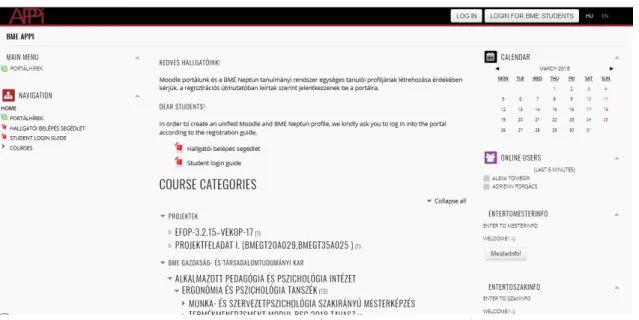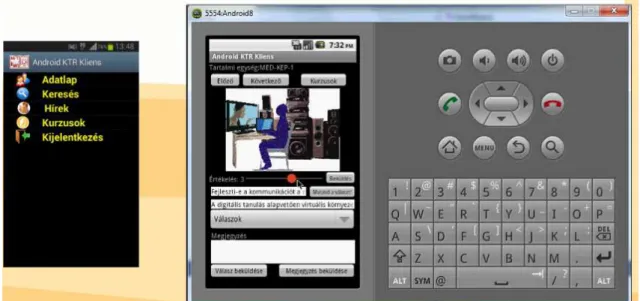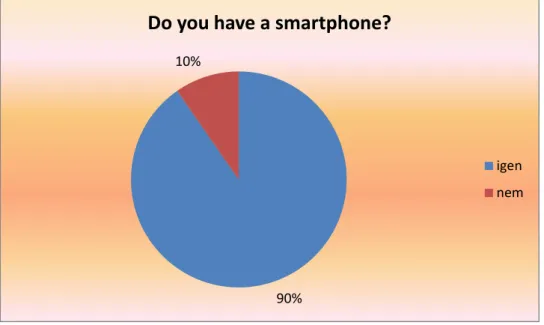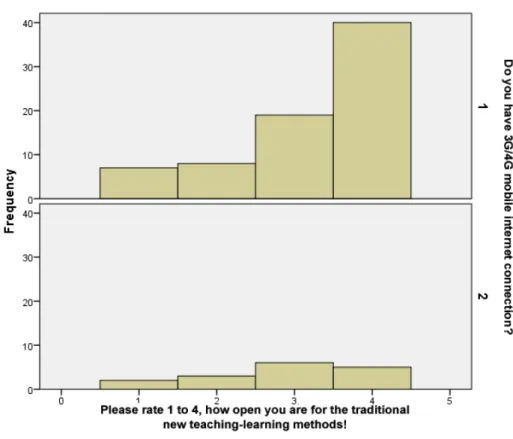The Role of Mobile Devices Supported Education and Open Content Development in the Learning
Process
György Molnár
Department of Technical Education, Budapest University of Technology and Economics, Budapest, Hungary
molnar.gy@eik.bme.hu
Abstract
In the world of constant changes, due to the constraint of continuous learning and the transformation of the economic and social environment, the changes in pedagogy are clearly outlined. In digital age are students are faced with many changes within the framework of socialization, institutional education and formal, informal and informal learning. For example, with changing technologies and its widespread and constant implications. Starting from this fact, the author can describe the importance of digitalisation at all levels and forms of schooling. The rapid expansion of mobile devices has almost forced it to be widely used in education. Cloud-based learning is another way of teaching. The new methodological solution has a lot of potential to support the learning process. One important point here is the altered way of content development and the changed habits of mobile devices use. In this article, the author presents the results of an empirical qualitative survey, which was completed in the autumn of 2017 in higher education in Hungary. The focus of the study was the mapping of content consumption and content creation habits developed by their own digital devices.
Keywords
Mobil learning. E-material. ICT. BYOD. Network-based learning. Web 2.0.
INTRODUCTION
In today’s information society, in which the increased value of not only information but information technology has become significant, the concept of the digital divide has gradually been given a new meaning: it has become a qualitative indicator of the use of devices, information flow and transfer. That is to say that while earlier access to devices was the indicator of digital literacy for nations and nation states, today it has become the indicator of support for information flow and communication processes. This process is illustrated by the fact that the penetration of mobile communications devices and internet access has today reached a point whereby every second person owns a device and its inherent services. Further, at a global level there are 2-3 mobile telephones and subscriptions for every person. The age of mobile devices has brought unprecedented interaction. Reception of the concept of Web 2.0 has often referred to the emergence of a participatory web culture. According to this understanding the user is not merely a
recipient of online content, but also an active creator of such (Szűts, 2014a; 2014b). This goes beyond content development and speaks to the enrichment of content, content creation and sharing, all simultaneously (Dragon, 2008). All this is executed in virtual and digitalised space, independent of space and time. In this sense education has become virtually all-encompassing in terms of openness, reflectivity on problem-solving thinking and the opportunities for mobile learning (Benedek, 2013). The most important areas of information competence are described in the Hungarian National Core Curriculum, while the framework for digital competence for students is based on the recommendations of the internationally accepted Digcomp 2.1, while the viewpoints of educators is set in dickomp.edu and of public education institutions in digcomp.org. Vocational training is in a special situation in this regard, because on one hand it is one of the more essential fields of technical and technological innovation, while on the other hand it must provide responses to cutting edge technology (currently industry 4.0).
THEORETICAL OVERVIEW
In a world of constant change felt in daily life, thanks to the effects of the necessity of permanent learning as well as the forever changing economic and social environment, the phenomena of the paradigm shift taking place in education are becoming clear. In today’s digital age people face the devices of technical change, its technologies and its omnipresent consequences within the framework of socialization, institutional education and formal, non-formal and informal learning. Using this fact as a starting point, we easily anticipate the inevitability of digitalization at all levels and in all forms of education.
A result of the current expansion of technical advances is that the time frame and positive effects of dominant natural spontaneous learning and socialization decrease (Bárdos, 2007). The socialization medium of the school takes on an operational nature.
The effectiveness of education ceases to rise and stagnates. Pedagogical science speaks of dominance shifts; in this current latest phase the goal is the establishment of competence- based content regulation and institutional education. József Nagy wrote of this in the article “A kompetenciaalapú tartalmi szabályozás problémái és lehetőségei [The regulation problems and opportunities of competence-based content]” (2005).
The first dominance shift will replace spontaneous socialization and natural, undirected learning (which emerged with literacy) with deliberate learning and derivable and acquirable knowledge, which will become authoritative. Schools based on receptive learning and knowledge have been established. Motivation necessary for daily life and professional activity have remained in the school of life and in spontaneous socialization and has developed in non-deliberate reception activist learning (Mészáros, 2014). For more than a hundred years directions in reform pedagogy have aimed to replace knowledge-dominated learning (schools) with active learning. The birth of the theory and practice of such deliberate active learning is itself the second dominance shift. Alternative schools essentially emerged as parts of activity-oriented schools, although they have been unable to penetrate the school system as a whole in any country. In Hungary the active school fetish wave arrived and reached vocational education in the early and mid- seventies, carrying with it numerous contradictions and problematic situations. One such example was the active/activist teaching of basic public education subjects in vocational schools. Experimental teaching of subjects like chemistry and physics took place in classes
that were not broken down into smaller groups, causing numerous organizational issues.
Consider, for example, a class of 36 freshman who are expected not only to become familiar with the education institution type and its expectations, but were also faced with active learning demands that “burdened students and of course teachers as well” (Lükő, 2015).
The third dominance shift has become possible in the situation that has emerged today, namely that in the regulatory framework of competence-oriented and -based institutional education personality development becomes possible through components of established competencies and personality.
In my view what we see today is the beginning of a fourth dominance shift which can be called mobile learning or the dominance of digital pedagogy. We are witness to the effects of the changing learning environment (Balogh et al, 2011) , which are pushing at the walls of the school. An ICT-based, very pluralistic and changing, spatial and temporal course learning system is unfolding, and today’s concepts are hardly capable of describing or grasping the new reality. This has been discussed in the book “Digitális pedagógia [Digital Pedagogy]” edited by András Benedek.
In the societies of the modern age the motors of globalization and technical development have resulted in a paradigm shift, innovation and technological- methodological change in teaching and learning (Holik, 2015; Simonics, 2017). A new sub- section of science and practice has embarked on its victory march under the name digital pedagogy. The term digital refers to the ideas that the construction and operation of modern electronic devices is based on unique signal creation and transfer, formally the
“two logical values” of signals (yes, no). The sociological aspects, schooling, education policy crises, solutions and connectivities of this digital world are discussed by István Bessenyei and others in the study “Tanulás és tanítás az információs társadalomban - Az e- learning 2.0 és a konnektivizmus [Learning and Teaching in the Information Society - E- learning 2.0 and Connectivity]” (Bessenyei , 2007).
Bessenyei considers reform pedagogy, the phenomena of the worldwide crisis in education, the historical context and scientific analysis through the work of Freinet, Philip H. Combs and Illich. Modern ICT devices first spread traditional knowledge-sharing forms in Web 1.0, then Web 2.0 and finally e-learning 2.0. Digital natives not only seek information on the web, but also become content providers (Bessenyei, 2007:203). Web 1.0 was not yet fully interactive, but it made possible learning organization based on the internet, i.e., Learning Management Systems (LMS). These organized various databases, communications devices, divisions of tasks and administration into units (Balogh et al., 2012).
In his study Bessenyei refers to Castells and to Kristóf Nyíri, Barabási and Csermely to describe the relationship between network elements and e-Learning 2.0. The learning element of the information age is connectivity. Its founder was Georg Siemens, who went beyond behaviorism, cognitivism and constructivism to shed light on how learning took place in organizations and networks (Siemens, 2005; Balogh et al., 2011).
Digital pedagogy focuses on the following contents and activities, as well as communications devices: the development of communication-management in learning, collaborative and cooperative learning, the use of blogs and the relations of virtual institutions.
Through the background support of web 2.0 and e-learning 2.0 new education information methods came to be (Ollé, Papp, Lévai, Tóth-Mózer, Virányi; 2013), which often significantly reformed the learning environment with the methodological system of new media (Forgó, 2017). As such we reached the newest accomplishments of entirely digital pedagogy 2.0 (Benedek, Molnár; 2014). The continuation of this direction, Web 3.0, is unfolding and points beyond current technologies. Besides earlier services it assist intelligent orientation in large collections of data, places distributed mobile technologies in the forefront and further provides spaces for, among other things, the first steps of new technologies like artificial intelligence.
Relying on my previous research it has become increasingly clear that classrooms—
the centuries-old environment for learning—have become completely spread and opened through the tools, methods and educator roles of digital pedagogy.
The rapid spread of mobile devices has for all intents and purposes forced their widespread use in learning, and cloud-based learning is again a learning-teaching method of a different dynamic. The new methodological solution contains vast potential in the support of the learning process, one of the essential points of which is the development of content consumption and content creation habits through own mobile devices.
The concept of m-learning usually means access to content related to learning anywhere at any time through mobile devices, along with learning activities related to such. More precisely, it refers to that kind of learning through which an existing online CMS or LMS system can be accessed through a mobile networked device capable of executing communication (Balogh - Koprda, 2014.). These conditions are met foremost by the category of smartphones, tablet PC-s and i-Pads. An example of such a smartphone is the Samsung GalaxyTab touchscreen device, with which web content and a full range of multimedia is accessible at will. The intelligence of mobile devices is limited by the character of the accessible content (web 2.0, flash, audio, video). Smartphones available today run on various operating systems, which makes compatibility somewhat problematic (Balogh et al., 2015). The key examples of such systems are the long-familiar Symbian, the Windows phone, the new Android, Apple iOS, Bada and the Blackberry platform. The other key challenge for these devices is that web presence should be optimized for mobile screens (unique CSS, optimized contents) in the interest of seamless content use. Despite these aspects, a large number of people make use of the possibilities of m-learning, and a majority of developers are headed in this direction, e.g., the official Moodle Mobile client has been completed for the now well-known Moodle LMS system (Molnár & Benedek, 2014). Though these systems are predominantly used in higher education they are increasingly employed in public and vocational education areas. The following screenshot is of the Moodle learning environment developed and distributed by our department in 2006. In its appearance it fully executes the responsive content presentation criteria expected today.
Figure 1: The Moodle system of our Department, own photo
The appearance of electronic learning environments has undergone generational development, through which the aesthetic of new content-management Wordpress websites was followed by a built-in LearnPress LMS extension. The following Budapest University of Technology and Economics Electrical Engineering Faculty’s “VIK Open” online course system is an example of such.
Figure 2: The Moodle Environment of VIK open, own photo
The connection of the work of students, teachers and prospective teachers in open curriculum development is a unique interaction chain, of which one of the cores is the Hungarian Academy of Sciences methodological research project unfolding in the department. A part of this is a curriculum development effort supported by a micro- content based and scaleable cloud service, which we are designing to build on the experiences of our practicing expert lecturers as well as the needs of our students in professional training. We are basing the executed professional methodology open curriculum on student use via mobile devices, which is attainable by developing mobile applications from the content consumption side. To support content development we aim to develop and test a cloud-based dynamic databank-management platform. The following
figure presents a micro-content based m-learning framework from an earlier R+D project, which illustrates the LMS structure, with main menu functions accessible on the left side.
The figure’s right side shows the micro-content-based curriculum elements and the related self-checking test questions as presented on a mobile telephone.
Figure 3: Mobile learnig framework, own photo
EMPIRICAL ASSESSMENT RESEARCH OF MOBILE DEVICES SUPPORTED EDUCATION
Thanks to the nature of the information age students in higher education wish to study through an ever-expanding horizon of quick and comfortable access to information.
As such, they are already accessing basic texts via the internet. A portion of students would rather approach education materials instinctively, in accordance with daily user practice, using their smart devices. To assist their efforts it is necessary to offer information in an institutionally operated manner. Students have a range of expectations, and the generation socialized through the internet is now entering higher education.
Recently hired faculty members are much more ICT-oriented that earlier generations. In the framework of our research we have studied the digital competence skill levels of various generations, ICT device use habits and the effects of utilized ICT and experiential- pedagogy methods. An open question we faced consistently concerned how the use of modern ICT-based mobile devices would affect the process of teaching-learning. Are there successful ICT application strategies, and if yes, what are they? To explore answers we conducted a quantitative questionnaire survey in the fall of 2017, using a simple stratified sample of N=150, with the target group being full-time students within the higher education base. The size of the useable sample was N=94. Our exploratory method employed an interactive, experiential (kahoot) measurement tool. Our survey employed methodological support on own devices, i.e., the BYOD method. The target group was composed mainly of engineering students from the Y and Z generations who were continuing their studies in a higher education institution. Our survey used largely closed questions, the answers to which we analysed using simple descriptive statistical methods which we presented through diagrams. Among the multivariate statistical procedures
available, we used the Kruskal-Wallis analysis method. Below we present some more significant and characteristic results, acknowledging the limitations of the survey.
Figure 4: The distribution of age of the respondents, own chart
The age distribution of the respondents is shown in Figure 4, in which we easily see that all of the student cohort is part of the digital (Howe & Strauss, 2000) or Z generation, just as theory would predict. The age distribution also shows that the majority of our respondents were freshmen. The largest group of subjects had begun their studies immediately after secondary school, which is apparent given that a majority of 53, i.e., almost half the respondents, was 19 years of age, with 20% being 20, and 17 of them being 18. Answering another question, many marked themselves as members of the Y and alfa generation, despite the fact we had clarified generation theory previously.
Figure 5: The distribution of students' openness in modern, new generation teaching methods, own chart
Figure 5 answers the question of the degree of openness the respondents had to modern, new style open teaching and learning methods. The results show that 50% of the
17
53
19
5 0
10 20 30 40 50 60
18 years old 19 years old 20 years old 21 years olds
Please, state your age!
10%
12%
28%
50%
Please, evaluate from 1 to 4 the how open are for the new teaching- learning methods. "4" indicates the "most open state".
1 2 3 4
respondents were fully open to new education and learning methods (4), while almost another quarter, or 28% were very open to new methods (3), while only 12% and 10%
stated that they were less inclined to be open to new generation teaching methods in the process of learning.
Figure 6: Distribution of respondents by mobile phone, own chart
Figure 6 explores the proportion of students that own a mobile telephone. As seen in the chart, 90% of the respondents own a smart phone.
Figure 7: Distribution of respondents by mobilapps download, own chart
In Figure 7 we explore downloading habits and mobile telephone applications. We found that the majority of respondents (55%) only downloaded apps to their phone occasionally, while 34% stated that they are regular app downloaders. The responses show that 11% of the subjects did not download apps to their mobile telephone.
90%
10%
Do you have a smartphone?
igen nem
34%
55%
11%
Did you download mobilapps to your smartphone?
Rendszeresen Néha
Nem
In the following paragraphs we will examine a few relations through multivariate statistical analysis, for which we utilized the SPSS 23 program. Due to a technical problem our sample size was N=93 or 92. Our analysis resulted in two unique results. The first was reached by using the Kruskal-Wallis test.
Figure 8: The relationship between mobile Internet use for different generations, own chart
There is overall no difference in smart phone ownership between generations and age cohorts. However, it is clear that those claiming they are members of the alpha generation are “exceptions” as there are more students among them who do not have a smart phone than students who do.
In the next analysis we employ the Mann-Whitney test, because in our case we had binary variables as independent variables.
Figure 9: Openness to mobile and learning methods, own chart
Comparison was more difficult in the analysis shown above (Figure 9), because there were hardly any students who did not have a mobile phone (8 of 91). As such we could not have produced a significant deviation, but it can be said of those who have a smart phone that openness to new generation methods increased to the maximum, while those who did not own such a device were either completely open or were full rejectors (the two subgroups having almost the same numbers). The average for smart phone owners was 2,94 while for non-owners it was 2,87. As such there is no significant difference, but the distribution of openness was different in this field.
CONCLUSION
New competences in higher education are constantly changing and developing, with innovation, creativity and the new learning environment gaining an increasingly significant role. Based on the analysed sample we can establish that ownership of modern digital and ICT devises and access to the internet have been secured and that the desire for up-to- date teaching methods is an unequivocal expectation of current students in the school institutional system. Regarding the use of the new methods and digital content as well as the framework systems, students are generally partners and offer support for educator initiatives and efforts at renewal. There is not yet a clear recipe for the use of new ICT- based effective methods, but at the level of micro-activities we increasingly frequently experience changes in methodological culture.
Regardless of when, the historical message of knowledge able to respond to challenges of the given age is of importance to all higher education institutions.
In this study the size of our analysed sample (which was rather small, at 94 respondents), the large number of generations and the small age differences among respondents did not make it possible to uncover significant differences among generations. At the same time we can state that the characteristics of the students pointed in one direction in a basically homogeneous manner. For this reason the Kruskal- Wallis test did not find differences among them. Ownership of a smart phone is characteristic of all the age groups, with those of the age of 18 (i.e., the youngest) having the lowest access to smart phones.
Overall the effects of the variables analysed as a whole allow us to state that having these attributes and being of this age influences acceptance of new-style learning methods. Based on this it is my position that we can establish that student openness must by all means adapt to the integration of up-to-date pedagogical methods and tools of the pedagogical profession in the teaching process.
ACKNOWLEDGEMENT
This study was written with the support of a János Bólyai Research Scholarship.
REFERENCES
Balogh, Zoltan; Turcani, Milan; Magdin, Martin; et al., 2012. Creating model educational processes using petri nets implemented in the LMS, 9th International Conference on Efficiency and Responsibility in Education, EFFICIENCY AND RESPONSIBILITY IN EDUCATION pp. 7-16.
Balogh, Zoltan; Klimes, Cyril; Turcani, Milan, 2011. Instruction adaptation modelling using fuzzy petri nets, International Conference on Distance Learning, Simulation and Communication (DLSC), DISTANCE LEARNING, SIMULATION AND COMMUNICATION (DLSC 2011) pp. 22-29.
Balogh, Zoltan; Koprda, Stefan, 2014. Application of Petri Net for Evaluation Modeling of Student in the LMS, 10th International Scientific Conference on Distance Learning in Applied Informatics (DIVAI), Sturovo, Slovakia, pp. 229-239.
Balogh, Zoltan; Koprda, Stefan; Hruby, Dusan; et al., 2015. Proposal of the irrigation system using low-cost Arduino system as part of a smart home, IEEE Conference: 13th IEEE International Symposium on Intelligent Systems and Informatics (SISY), Subotica, Serbia, pp.
229-233.
Bárdos Jenő, 2007. A nyelvpedagógiai tudás jellege, In: Sárdi Csilla (ed.) Kommunikáció az információs technológia korszakában: MANYE XVII. : XVII. Magyar Alkalmazott Nyelvészeti Kongresszus. Székesfehérvár; Kodolányi János Főiskola (KJF), 2007. pp. 14-32.
Benedek, A., 2013. New educational paradigm: 2.0: items of digital learning, In: Benedek A.
(ed.) Digital Pedagogy 2.0. Budapest, Typotex, pp. 312
Benedek, A.; Molnár, Gy., 2014. ICT in Education: A New paradigm and old obstacle. In: The Ninth International Multi-Conference on Computing in the Global Information Technology.
Arno Leist, Tadeusz Pankowski (ed.) Sevilla: IARIA, pp. 54-60.
Bessenyei István, 2007. In: Szerk. Pintér Róbert: Az információs társadalom Tankönyv, Gondolat - Új Mandátum Kiadó Budapest
Dragon, Zoltán 2008. „Mi vagy te, web kettes interaktivitás?”
http://www.dragonweb.hu/blog/mi-vagy-te-web-kettes-interaktivitas/ [Accessed 30.12.2017.]
Forgó Sándor, 2017. Új médiakörnyezet, újmédia-kompetenciák, In: Forgó Sándor (szerk.) Az információközvetítő szakmák újmédia-kompetenciái, az újmédia lehetőségei. 152 p. Eger:
Líceum Kiadó, 2017. pp. 9-24. (ISBN:978-615-5621-35-2)
Holik Ildikó, 2015. Szakmai tanárok módszertani repertoárja, In: Tóth Péter, Maior Enikő, Pogátsnik Monika (szerk.) Tanári és tanulói kompetenciák az empirikus kutatások fókuszában. Nagyvárad, Románia, Budapest, Óbudai Egyetem Trefort Ágoston Mérnökpedagógiai Központ, pp. 35-54.
Howe Neil − Strauss, William, 2000. Millennials Rising: The Next Great GeneraŠon. Knopf Doubleday Publishing Group.
Lükő István, 2015. Szakmai nevelés és szakmai szocializáció, Opus et Educatio, Vol 2, No 2, pp. 17-25.
Mészáros Attila, 2014. A felsőoktatás humánerőforrás kutatásához alkalmazható HS mérőrendszer bemutatása, In: Mészáros Attila (szerk.) A felsőoktatás tudományos, módszertani és munkaerőpiaci kihívásai a XXI. században. Győr: Széchenyi István Egyetem, pp. 20-30. (ISBN:978-615-5391-32-3)
Ollé János, Papp-Danka Adrienn, Lévai Dóra , Tóth-Mózer Szilvia, Virányi Anita, 2013.
Oktatásinformatikai módszerek ELTE Eötvös, Budapest, pp.150, ISBN: 97896331215734, http://www.eltereader.hu/kiadvanyok/vi-oktatas-informatikai-konferencia-
tanulmanykotet/, [Accessed 30.01.2018.]
Siemens, George, 2006. Knowing Knowledge. Letöltés:
http://www.elearnspace.org/KnowingKnowledge_LowRes.pdf [Accessed 26.06.2015.]
Siemens, George: Connectivism, 2005.”A learning theory for the digital age.” International Journal of Instructional Technology and Distance Learning (ISSN 1550-6908),Vol 2. No. 1.
http://www.itdl.org/journal/jan_05/article01.htm [Accessed 20.04.2014.]
Simonics István, 2017. Mérnöktanárok és mentortanárok IKT eszköz felhasználása, In: Mrázik Julianna (szerk.) HERA Évkönyv 2016: A tanulás új útjai. Budapest: Magyar Nevelés- és Oktatáskutatók Egyesülete (HERA), 2017. pp. 298-315.
Szűts Zoltán, 2014a, Egyetem 2.0: Az internetes publikációs paradigma, az interaktív tanulási környezet és a felhasználók által létrehozott tartalom kihívásai a felsőoktatásban, Kodolányi János Főiskola (KJF), Székesfehérvár, pp.114
Szűts Zoltán, 2014b. Bevezetés az internetpedagógiába, http://e- nyelvmagazin.hu/2014/12/03/bevezetes-az-internetpedagogiaba-halozati-tanulas-halozati- tudomany-halozati-tudas/ [Accessed 20.11.2017.]





